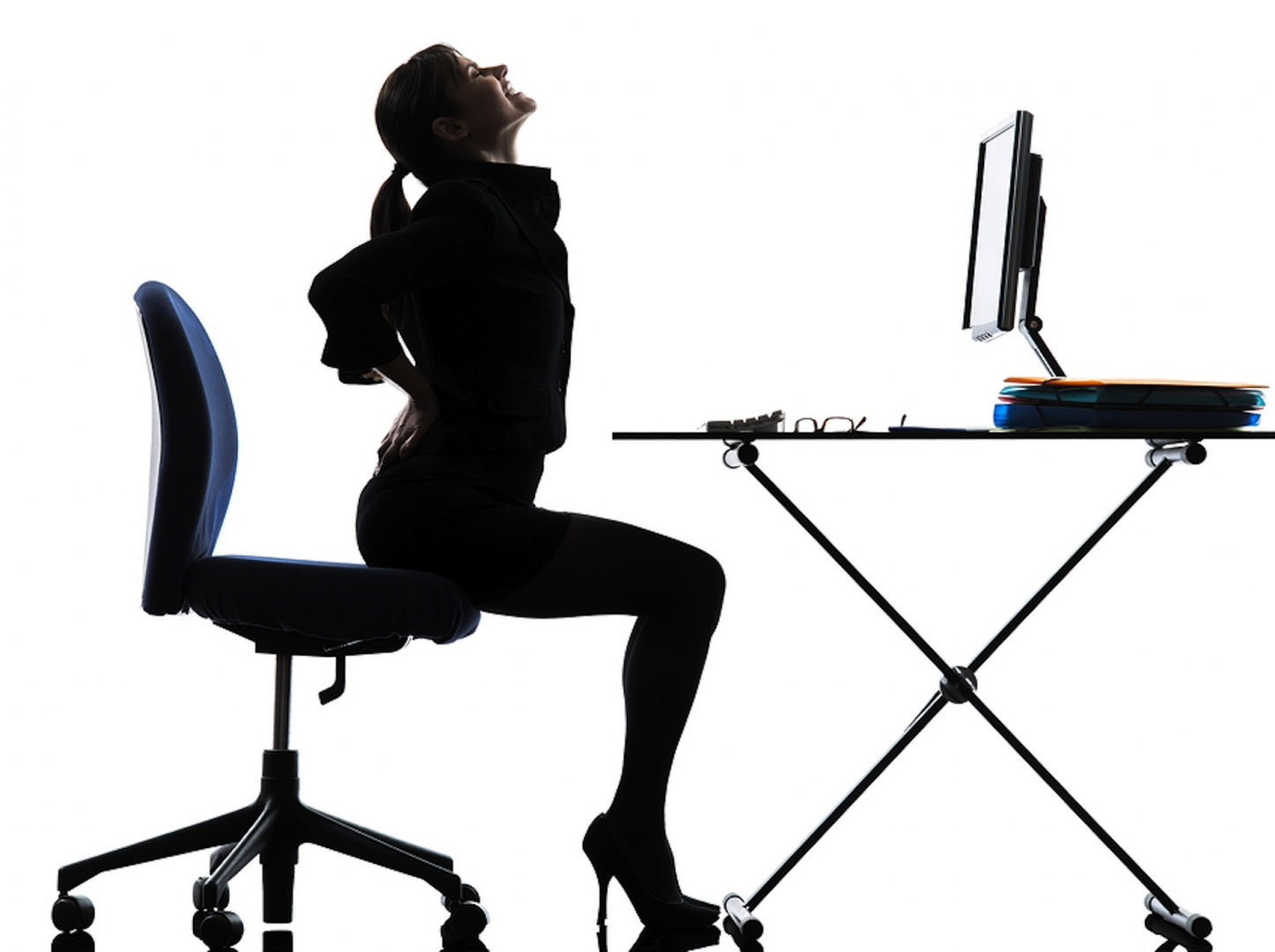Sitting Is Really The New Smoking, and it's Killing You ! [infographic)

Did you know that most of us spend more time each day sitting than sleeping?
According to researchers, the average person sits for 9.3 hours daily! This is significantly more than the 7.5 hours of shut-eye that we typical get each night!
However, the human body is naturally designed to move, not sit, and the alarming consequences of our sedentary lifestyle are only just coming to light.
Discover why sitting may just be the ‘smoking’ of our generation and what we can do to fix it!
Our Modern Day Sitting Society
The typical work week is a sitting-cycle of “drive”, “desk” and “couch”.
This is a far cry from how humans have lived for the last few millennia. Before technology, the human lifestyle was inherently active. ‘Movement’ and ‘exercise’ weren’t separate activities that needed to be scheduled - they were simply part of everyday life.
In fact, the chair only became a common household fixture in the last couple of centuries! In the overall span of human evolution, this makes prolonged sitting a relatively new phenomenon.
Many of us already feel the backache, tension headaches and sluggishness that come from a sedentary lifestyle. However, new research is suggesting that the impact of sitting on our health may be far more serious than poor posture and some aches ‘n’ pains.
In fact, according to Dr James Levine, the director of Mayo Clinic - Arizona State University Obesity Solutions Initiative,
“Sitting is more dangerous than smoking, kills more people than HIV and is more treacherous than parachuting. We are sitting ourselves to death.”
This is a very bold (and slightly confronting!) statement. So what’s the science to back it up?
Numerous studies strongly suggest that prolonged periods of sitting increases our risk of chronic disease, such as diabetes, cardiovascular illness and even cancer.
And Do You Want To Know The Real Clincher?
This risk is not reduced by daily exercise.
In the word of an expert, "Going for a run or walking the dog doesn't counter [inactivity]. It's about total energy expenditure across the whole day."
In a longitudinal study that followed over 100,000 men and women over a 14 year period, people who sat more than six hours per day had a significantly higher risk of mortality than people who sat for three hours or less daily. This risk was not changed by the subjects’ levels of physical activity outside of their sitting time.
Indeed, numerous studies indicate that the health impacts of continuous sitting cannot be reduced through daily exercise. Even in physically active people, sitting increases their health risks. And this risk has been found to increase with every two hours of time spent sitting.
It gets worse. For every hour that we spend sitting and watching television, we take up to 22 minutes from our lifespan.
If you’re still not convinced that sitting might really be the new smoking, check out these amazing facts !
Sitting 6 hours or more every day increases your risk of mortality by 40% more than people who spend less than 3 hours of their day sitting.
- Sitting requires almost zero energy!
- The activity of our fat-metabolizing enzymes drastically decreases when we sit.
- Within 24 hours of sitting, our good cholesterol decreases by 20% and the effectiveness of insulin plummets by 24%.
- Those of us with sedentary jobs have double the risk of heart disease than our peers who work in standing roles.
- People who watch 3 hours or more per day of television have a 64% increased risk of mortality from heart disease.
WHY? How Can Sitting Cause So Much Harm?
As soon as our backsides hit the chair, several metabolic and physical changes start to occur:
- Our resting metabolic rate plummets, which means that your body burns minimal calories. This helps to explain why increased sitting is associated with higher rates of obesity.
- The electrical activity in our leg muscles drops right off.
- Blood circulation in our legs becomes sluggish. (Hello, varicose veins!)
- Prolonged sitting also shortens, tightens and weakens our hip flexors. It also makes our glute muscles ‘switch off’.
- Our bodies produce higher levels of triglycerides and C-reactive protein (which is indicative of inflammation).
Other studies have also shown that women who sit six hours per day or more experience a drop in bone density of 1% each year.
So What’s The Solution?
It’s simple, yet complicated: Reduce the amount of time we spend on our derrieres. This means increasing our overall daily movement.
Sitting less sounds like a simple concept. However, the reality is that much of our culture is centered around sedentary activity.
Many of us work in office jobs that clock up significant sitting hours. Social gatherings tend to center around eating. Many of us enjoying unwinding on the couch with the TV or a good book at the end of our work days.
Nilofer Merchant at TED 2013 comments on the social trend of sitting this way:
“Sitting is so incredibly prevalent that we don’t even question how much we’re doing it. And because everyone else is doing it, it doesn’t even occur to us that it’s not OK.”
While a ‘standing revolution’ isn’t likely to happen overnight, the great news is that we can implement small, consistent changes that will make a big difference to reducing our risk.
Here Are Some Solutions To Consider:
- Do ‘walking meetings’ at work - the extra sunshine, fresh air and oxygenated muscles will make you feel invigorated and far more productive once you return to the office!
- Break up long-drives with frequent rest-and-stretch breaks. If you have regular, long commutes to work, this is also important for your concentration and safety as a driver.
- Trial “active sitting” on yoga/exercise balls at your desk. You still need to get up and stretch regularly but these balls do engage more of your muscle groups than regular desk chairs.
- The GOLD STAR SOLUTION… Get a standing or treadmill desk! Admittedly, these can be more expensive than regular desks. However, we all need to stand up for our right to stand up! Start by kindly communicating the benefits to your employer, or even negotiate a desk upgrade as part of your bonus scheme. You can also improvise by using a laptop on a benchtop or high counter.
- Suggest walking "catch ups" with friends, rather than over a meal or coffee.
- Set a timer on your phone or computer to stand up and stretch every 10 to 15 minutes. Yes, I know this sounds disruptive but it’s truly so important for your health! With time, you won’t even need the timer any more because your body feels so good with a stretch. That extra oxygenation is good for your brain and productivity too.
- Stand up while you take phone calls.
- Park your car further from the office to add a little extra walking into your day.
- Ride a bike instead of taking the car, whenever possible.
- Opt to stand up on public transport, rather than taking a seat.
- Look for opportunities to interrupt sitting time at work - walk to the printer, take bathroom breaks on another floor level, use the stairs instead of elevators.
- Use ad breaks on TV as a reminder to get off the couch, stretch and walk around.
- Walk over to speak with a work colleague, as opposed to emailing or phoning from your desk chair.
- While reading, use the end of each chapter as a reminder to stand up and stretch.
Don’t discount the power of these small steps! Every time you take a moment to stand and move, your body kick-starts the processes needed to metabolize fat and breakdown sugar. This benefits the health of your entire body and boosts your metabolism too
 .
.
Also in News

Gym Goers, Bodybuilders, Boxing Clubs and Athletics Love The Benefits Of “The Feel Good Drink”

How To Eat Less And Not Feel Hungry Or Your Money Back!

